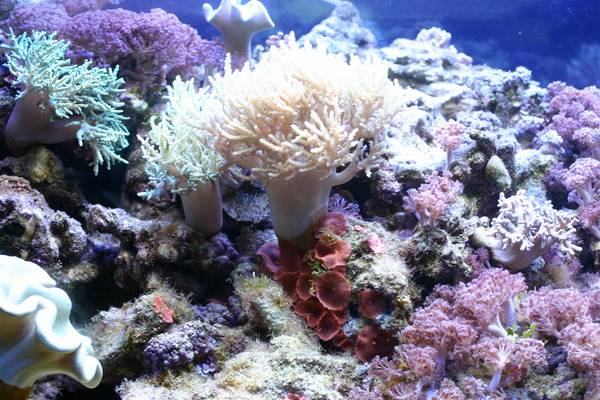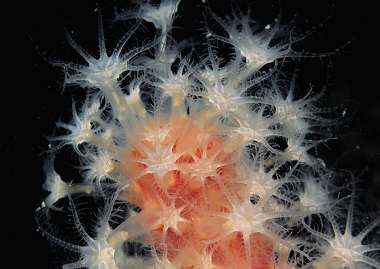
CORALS.
FAR away in the warm waters of the great tropical seas is a little marine creature, scientifically called a polyp, or zoophyte, which in its operations completely out-strips all the works of man.
This tiny animal produces the beautiful corals, red, white, black, and other shades, which are sold in the shops of the jeweler and lapidary, or are preserved in cabinets. Although so small and helpless, this little bunch of jelly produces the most astonishing results.
In that part of the Pacific Ocean called Polynesia, which equals the continent of Asia in size, are found groups of low islands, and great reefs of rocks, hundreds and hundreds of miles in length, which owe their existence entirely to the coralline polyp. Frequently these little workers will push up out of the water a coral reef of a circular form, varying in diameter from a few hundred rods to twenty-five or thirty miles. These regularly-formed islands are called by the natives atolls, a word of Malay origin meaning "order."
Inside of these reefs is a lake, or lagoon, many fathoms in depth, where ships may sail, or ride at anchor. These reefs are seldom more than a few hundred yards in width, yet there the cocoanut tree readily takes root, and sends up its tall trunk skyward, presenting a very picturesque appearance.
Here, too, the natives often erect their fragile huts, and repose in the shade of the cocoanut branches.
The atolls usually have one or more openings, through which small vessels may come in and pass out. The engraving represents one of these lagoons in the great South Sea, with a ship on its quiet waters. However much the sea outside may rage and foam, all is comparatively quiet on the inner side of the atoll.
The waters are said to be dark green. There are thousands of these atolls, large and small, in the great Pacific and Indian Oceans, which the little reef-builders, the coral-producing polyps, have pushed up out of the depths below.
Could we descend into the heart of the seas where the coral insect dwells, we would be in ecstasy at what we saw. Here we would behold vast sea-gardens rivaling the shrubbery of our most beautiful parks in grace and beauty. The brilliant hues of red and white and pink, and other beautiful tints, which adorn the vegetable world, are found in their perfection in the coral gardens down in the ocean.
Frequently they imitate the form of trees, and excel them in beauty. Some species develop their coral product in the form of large leaves, rolled around one another like a huge cabbage. Other kinds are foliated, and look more like a bunch of lettuce Some of the clustered varieties remind one of the acanthus and oak. One species is like an asparagus bed. The appearance of mushrooms and mosses and lichens is imitated by other kinds, while a certain other variety reminds one of asters and carnations and pink beds. Still others, with their beautiful tints and hues, call to mind the most lovely flowering vines.
But while we may be interested in the countless wonders of the coral kingdom, let us not forget that this little polyp is one of the divinely-appointed agents to help keep pure the waters of the great seas. The waters of the ocean are purified by passing through the great coral forests of the sea depths, as the air is purified by being driven through natural forests and among mountain gorges. Here we see the wisdom of the One who made the sea and the dry land.
From time immemorial, coral has been a well-known article of commerce. And for obtaining this product of the sea, there are noted coral fisheries in different parts of the world. Most of the corals, which adorn our cabinets, or are made into necklaces and beads, come from the Mediterranean Sea. The manner of securing these coveted treasures is well shown in the engraving. A great cross of wood loaded with stones, and carrying at the end of each arm a sort of net, is lowered from a schooner, with a man to manage it, and secure the precious substance. The branches of the coral are readily caught in the net; and with the man, speedily drawn to the surface. Sometimes a boat's crew will make a hundred dollars or more a day in this perilous kind of fishing. The business is carried on from April to September, in which there may be a hundred days when the men can work.
There are large coral fisheries off the Cape Verde Islands, controlled by the Spanish fishermen, who gather in more than a hundred thousand dollars' worth of coral annually. There are also fisheries of importance off Algeria, Tunis, and Morocco.
Red coral is obtained in the vicinity of Naples, and along the coast of Sardinia and Corsica. Extensive coral beds have also been discovered near Japan.
The Italians appear to take lead in coral manufactures. The province of Genoa alone employs five or six thousand persons in coral fishing and in manufacturing the raw material. There are many engravers of cameos and coral. To be valuable, coral must be in large pieces, of a delicate, pinkish, flesh-like hue, and uniform in tint. The flesh-colored is sometimes sold at fifty dollars per ounce. Red coral is frequently classified by dealers into five grades, as froth of blood, flower of blood, and blood of first, second, and third grades. Many of the finest specimens of red coral are sent to China, where they are used by the mandarins as buttons, to show their rank of office. Other kinds less valuable find their way to India, where they are highly esteemed by the natives, who imagine that the gods dwell in what look like the worm-eaten cavities. The writer once saw a magnificent bunch of coral, some three or four feet high, which a persevering sea-captain brought from the Indian Ocean. He secured it by ropes between the tops of the masts of his ship, and was thus able to get it home without breaking. There are very many interesting facts about coral, which the young readers must look up for themselves.
But while we have written so lengthily about coral, we would not close without reminding the reader that there is one thing which is far more precious than coral, and much more to be sought.
It is true wisdom.
The patriarch Job says:
"But where shall wisdom be found, and where is the place of understanding Man knoweth not the price thereof; neither is it found in the land of the living. The depth saith, It is not in me; and the sea saith, It is not with me. It cannot be gotten for gold, neither shall silver be weighed for the price thereof. It cannot be valued with the gold of Ophir, with the precious onyx, or with sapphire. The gold and the crystal cannot equal it; and the exchange of it shall not be for jewels of fine gold.
No mention shall be made of coral, or of pearls; for the price of wisdom is above rubies." Job. 28:12-18.
That every reader may secure this priceless treasure, is the fervent wish of the writer.
G. W. A.
